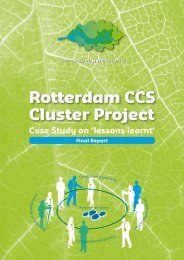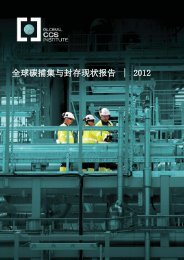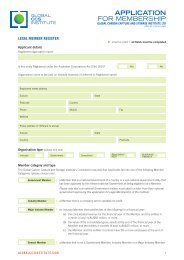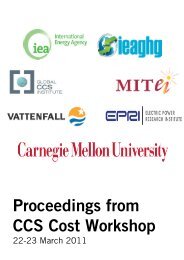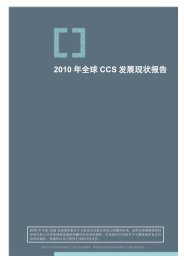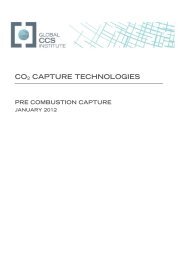Perceptions of CO2 Report - Global CCS Institute
Perceptions of CO2 Report - Global CCS Institute
Perceptions of CO2 Report - Global CCS Institute
- No tags were found...
Create successful ePaper yourself
Turn your PDF publications into a flip-book with our unique Google optimized e-Paper software.
6 Administration <strong>of</strong> the survey6.1 Testing phaseEighty respondents from Australia, 78 respondents from the Netherlands, and 816 respondentsfrom Japan participated in testing the survey to examine whether the questions were clear andcoherent. At five different stages throughout the survey, half <strong>of</strong> the respondents were randomlypresented with an additional question about its clarity. Respondents who found any parts difficult tounderstand or answer were asked to provide details in their own words. The testing phase alsoassessed the online survey’s implementation and functionality to ensure consistency across allthree countries. Any important feedback from this process was incorporated into theimplementation phase.6.2 Implementation phaseThe internet survey was completed by 2,470 respondents in total, with over 800 respondents fromAustralia, the Netherlands and Japan (see Table 2). Respondents completed the survey online andwere randomly presented with one <strong>of</strong> the nine survey conditions. As a result, each survey conditionwas provided to between 266 and 287 people.Table 2: Administration <strong>of</strong> the surveyCountry Survey period TestingphaseResponse RateConductingphaseResponserateNNAustralia April , 2010 80 48.8% 809 72.5%Japan March-April , 2010 816 36.7% 813 36.6% 8Netherlands April , 2010 78 Not available 848 47%In the testing phase, the Japanese researchers had a phenomenal response to their request forparticipants to trial the survey, hence the significantly larger number. Japanese panels weredirectly sampled from the population, whereas the Australian and Dutch panels were sampled viathe registered panels <strong>of</strong> polling firms as described in Appendix D. The different recruitmentmethods resulted in a variance in response rates. All panels <strong>of</strong> questionnaire participants closelyresembled national average demographics, with one exception: Australian survey recipients weremore likely to have completed bachelor’s degrees and masters’ degrees. Additional details on thebreakdown <strong>of</strong> panel participants by gender and age is found in Appendix D.8 In testing phase in the Japanese survey, a polling firm was used for sampling in order to trial the survey. In the conducting phase, thesample was directly taken from Japanese population. Respondents recruited directly from the population were not necessarilyaccustomed with participating in a survey like respondents registered as a panellist used by polling firms, which the Dutch andAustralian countries used. That might be a reason <strong>of</strong> the lower response rate for Japan in the conducting phase.14 | Understanding how individuals perceive carbon dioxide




